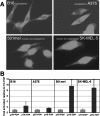Beta-catenin-induced melanoma growth requires the downstream target Microphthalmia-associated transcription factor
- PMID: 12235125
- PMCID: PMC2173224
- DOI: 10.1083/jcb.200202049
Beta-catenin-induced melanoma growth requires the downstream target Microphthalmia-associated transcription factor
Abstract
The transcription factor Microphthalmia-associated transcription factor (MITF) is a lineage-determination factor, which modulates melanocyte differentiation and pigmentation. MITF was recently shown to reside downstream of the canonical Wnt pathway during melanocyte differentiation from pluripotent neural crest cells in zebrafish as well as in mammalian melanocyte lineage cells. Although expression of many melanocytic/pigmentation markers is lost in human melanoma, MITF expression remains intact, even in unpigmented tumors, suggesting a role for MITF beyond its role in differentiation. A significant fraction of primary human melanomas exhibit deregulation (via aberrant nuclear accumulation) of beta-catenin, leading us to examine its role in melanoma growth and survival. Here, we show that beta-catenin is a potent mediator of growth for melanoma cells in a manner dependent on its downstream target MITF. Moreover, suppression of melanoma clonogenic growth by disruption of beta-catenin-T-cell transcription factor/LEF is rescued by constitutive MITF. This rescue occurs largely through a prosurvival mechanism. Thus, beta-catenin regulation of MITF expression represents a tissue-restricted pathway that significantly influences the growth and survival behavior of this notoriously treatment-resistant neoplasm.
Figures






References
-
- Bienz, M., and H. Clevers. 2000. Linking colorectal cancer to Wnt signaling. Cell. 103:311–320. - PubMed
-
- Brault, V., R. Moore, S. Kutsch, M. Ishibashi, D.H. Rowitch, A.P. McMahon, L. Sommer, O. Boussadia, and R. Kemler. 2001. Inactivation of the β-catenin gene by Wnt-Cre-mediated deletion results in dramatic brain malformation and failure of craniofacial development. Development. 128:1253–1264. - PubMed
-
- Chang, K.L., and A.L. Folpe. 2001. Diagnostic utility of microphthalmia transcription factor in malignant melanoma and other tumors. Adv. Anat. Pathol. 8:273–275. - PubMed
Publication types
MeSH terms
Substances
Grants and funding
LinkOut - more resources
Full Text Sources
Other Literature Sources
Medical
Molecular Biology Databases
Miscellaneous

